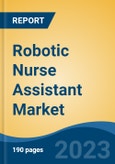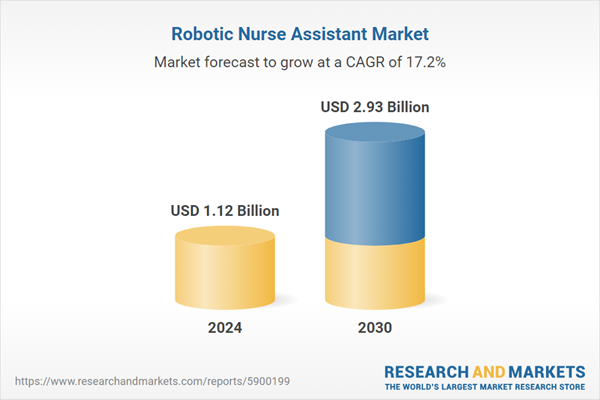Speak directly to the analyst to clarify any post sales queries you may have.
10% Free customizationThis report comes with 10% free customization, enabling you to add data that meets your specific business needs.
Robotic nurse assistants are sophisticated machines equipped with AI algorithms, sensors, and mechanical arms to assist healthcare professionals in various tasks. They can perform a wide range of functions, from routine duties like taking vitals and administering medication to more complex activities such as patient monitoring and data collection. These robots aim to alleviate the burden on healthcare staff, reduce errors, and enhance patient care quality.
The global demographic shift towards an aging population creates a higher demand for healthcare services, and robotic nurse assistants can help bridge the gap in caregiving. The shortage of healthcare professionals, particularly nurses, is a pressing issue in many countries. Robotic nurse assistants can alleviate this shortage by taking on routine tasks, allowing human healthcare workers to focus on more complex patient care. Advances in AI and robotics technology have made it possible for robots to perform tasks with greater precision and autonomy, enhancing their utility in healthcare settings. Robotic nurse assistants reduce the risk of human errors in medication administration and other critical healthcare tasks, thereby improving patient safety.
The global robotic nurse assistant market is at the forefront of technological innovation in healthcare. These intelligent machines are poised to transform patient care, enhance healthcare efficiency, and mitigate workforce shortages. As the market continues to grow and evolve, we can anticipate even more advanced and capable robotic nurse assistants, ultimately improving the quality of healthcare worldwide.
Key Market Drivers
Aging Population and Growing Healthcare Needs
The aging global population is one of the most significant factors driving the expansion of the Global Robotic Nurse Assistant Market. As the proportion of elderly individuals continues to rise, healthcare systems face increasing pressure to provide efficient, high-quality, and cost-effective care. Robotic nurse assistants are emerging as a key solution to meet these evolving demands by enhancing patient care, reducing the workload on healthcare professionals, and improving operational efficiency in hospitals, nursing homes, and assisted living facilities. The world’s population is aging at an unprecedented rate.By 2030, the global demographic landscape will undergo a significant shift, with individuals aged 60 years or older accounting for 1 in 6 people worldwide. This age group is projected to grow from 1 billion in 2020 to 1.4 billion by 2030, reflecting a 40% increase. Furthermore, by 2050, the population of those aged 60 and above is expected to double, reaching 2.1 billion. Notably, the segment of individuals aged 80 years or older is anticipated to triple during the same period, rising to 426 million by 2050. This demographic trend is particularly pronounced in countries such as Japan, Germany, the United States, and China, where declining birth rates and increased life expectancy are reshaping healthcare demand.
As older adults are more susceptible to chronic illnesses, mobility issues, and cognitive impairments, there is a growing need for continuous healthcare support and long-term caregiving solutions With a growing elderly population, the demand for nursing homes, assisted living facilities, and home healthcare services has surged. Traditional healthcare systems are struggling to meet these needs due to limited staffing and rising costs. Robotic nurse assistants are being deployed to fill this gap by providing: 24/7 patient monitoring and support, Automated assistance with feeding, dressing, and rehabilitation, Reduction in hospital readmission rates through better patient management, These robots enhance the quality of care while alleviating the burden on human caregivers, making them a viable solution for both healthcare institutions and home care settings.
Key Market Challenges
Regulatory Hurdles
One of the primary challenges faced by the robotic nurse assistant market is navigating complex and evolving regulatory frameworks. Healthcare is heavily regulated to ensure patient safety, data security, and compliance with ethical standards. As robotic nurse assistants become more integrated into healthcare settings, manufacturers and healthcare providers must adhere to stringent regulations, which can vary significantly from one country to another. This regulatory variability can hinder market expansion and lead to delays in product approval.Key Market Trends
Technological Advancements
In recent years, technological advancements have ushered in a new era of innovation in the healthcare industry. One of the most significant developments is the integration of robotics into healthcare services, particularly in the form of robotic nurse assistants. These robots are revolutionizing patient care and healthcare management worldwide. With the aging population, increasing demand for healthcare services, and the need for more efficient healthcare solutions, the global robotic nurse assistant market is experiencing remarkable growth.AI-powered robotic nurse assistants are capable of learning and adapting to different situations. They can analyze patient data, monitor vital signs, and detect abnormalities, allowing for early intervention and improved patient outcomes. Natural Language Processing (NLP) technology enables robots to understand and respond to verbal commands and engage in meaningful conversations with patients. This enhances patient engagement and reduces feelings of loneliness and isolation, particularly in long-term care settings.
High-quality sensors and cameras enable robotic nurse assistants to navigate through complex environments, avoiding obstacles and ensuring patient safety. These sensors also provide real-time data for monitoring patients and their surroundings. Some robotic nurse assistants are equipped with telemedicine capabilities, allowing remote healthcare providers to assess patients' conditions and provide guidance in real-time. This is especially valuable in rural or underserved areas. Integration with wearable devices such as smartwatches and health monitors allows robotic nurse assistants to track patients' vital signs and activity levels more accurately, helping healthcare providers make informed decisions.
Key Market Players
- Hstar Technologies Corporation
- Diligent Robotics Inc
- TOYOTA MOTOR CORPORATION
- RIKEN-SRK
- SoftBank Robotics Group
- Panasonic Corporation of North America
- Fraunhofer IPA
- Aethon, Inc
Report Scope:
In this report, the Global Robotic Nurse Assistant Market has been segmented into the following categories, in addition to the industry trends which have also been detailed below:Robotic Nurse Assistant Market, By Product Type:
- Independence Support Robots
- Daily Care & Transportation Robots
- Pharma Automation Robots
- Others
Robotic Nurse Assistant Market, By End User:
- Hospitals & Clinics
- Senior Care Facilities
- Homecare Settings
- Others
Robotic Nurse Assistant Market, By Region:
- North America
- United States
- Canada
- Mexico
- Europe
- France
- United Kingdom
- Italy
- Germany
- Spain
- Asia-Pacific
- China
- India
- Japan
- Australia
- South Korea
- South America
- Brazil
- Argentina
- Colombia
- Middle East & Africa
- South Africa
- Saudi Arabia
- UAE
Competitive Landscape
Company Profiles: Detailed analysis of the major companies present in the Robotic Nurse Assistant Market.Available Customizations:
With the given market data, the publisher offers customizations according to a company's specific needs. The following customization options are available for the report.Company Information
- Detailed analysis and profiling of additional market players (up to five).
This product will be delivered within 1-3 business days.
Table of Contents
Companies Mentioned
- Hstar Technologies Corporation
- Diligent Robotics Inc
- TOYOTA MOTOR CORPORATION
- RIKEN-SRK
- SoftBank Robotics Group
- Panasonic Corporation of North America
- Fraunhofer IPA
- Aethon, Inc
Table Information
| Report Attribute | Details |
|---|---|
| No. of Pages | 190 |
| Published | March 2025 |
| Forecast Period | 2024 - 2030 |
| Estimated Market Value ( USD | $ 1.12 Billion |
| Forecasted Market Value ( USD | $ 2.93 Billion |
| Compound Annual Growth Rate | 17.2% |
| Regions Covered | Global |
| No. of Companies Mentioned | 8 |









